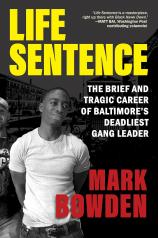Life Sentence: The Brief and Tragic Career of Baltimore’s Deadliest Gang Leader
Review
Life Sentence: The Brief and Tragic Career of Baltimore’s Deadliest Gang Leader
Fans of HBO’s “The Wire” and the recent “We Own This City” will feel at home in the pages of Mark Bowden’s LIFE SENTENCE. It’s a gritty chronicle of the rampage of one young drug dealer through the streets of Bowden’s hometown of Baltimore in the second decade of this century, alongside a subtle indictment of a society that created the conditions in which his subject’s criminality had fertile soil to grow. Bowden has had a long and estimable career in newspaper and magazine journalism, most recently at The Atlantic, and has produced books like BLACK HAWK DOWN. But he also brings a personal dimension to this story as someone who spent some of his youth growing up in the suburbs of Baltimore.
"There’s a seeming inevitability to the story that Mark Bowden skillfully tells in LIFE SENTENCE. But perhaps some people with the power to do something about it will read his disturbing book and be influenced to summon the will necessary to change its ending for future Tanas."
Montana Malik (Tana) Barronette was born in the impoverished West Baltimore neighborhood known as Sandtown in 1995. Abandoned by his father, with a mother who both sold and used drugs and a grandmother who strove mightily, but vainly, to set him on the right path through regular church attendance, by age nine he had stolen his first car. Not long thereafter, he was on the streets as an avid player in “The Game,” as the drug trade was known locally. Eventually, Tana parlayed his natural talent and charisma into leadership (along with his half-brother, Rell) of a gang (one of an estimated 320 in the city) known as Trained to Go (TTG). At its height, it was generating $50,000 in weekly drug sales on neighborhood street corners and even took part in producing widely seen videos to glorify its activities.
Well before Tana reached his 20th birthday, he had acquired a reputation as “Baltimore’s number one trigger puller,” a chilling distinction in a city where the homicide rate was more than seven times the national average. Members of TTG --- a group that Bowden persuasively characterizes as “essentially normal teenagers in an abnormal environment” --- were suspects in at least 10 murders committed to silence suspected informants, exact revenge or squelch competition. For most drug dealers, arrest and conviction led to (at worst) a brief prison term and a turn of the revolving door that had them out on “the corner” again before long. But as Bowden explains, when TTG turned to murder as a routine business practice, authorities realized that a more drastic response was required.
Bowden digs deeply into the meticulous efforts of a joint FBI and Baltimore Police Department task force that relied on the federal Racketeer Influenced and Corrupt Organizations Act (RICO) to transform the job of pursuing, and eventually convicting, Tana, Rell and six other members of their gang from case-by-case murder prosecutions into a sweeping indictment of their rampant criminality. The task force’s painstaking evidence gathering relied on wiretaps, controlled drug buys and, above all, the aid of confidential informants with nicknames like Pony Head and Fat Guy, who linked the gang members to this violent crime wave. Bowden singles out the contribution of Joe Landsman, a third-generation Baltimore police officer whose unglamorous and often dangerous work on the streets was instrumental in the successful prosecution.
Bowden is a journalist, not a sociologist or activist. But in his concluding chapter, he offers a frank judgment of the “racist societal effort spanning centuries” that made Sandtown into “exhibit A of intractable urban failure, a negative of the dazzling new image Baltimore strove to project,” with an unemployment rate of 16 percent and a poverty rate two-and-a-half times that number. In contrast, the placid suburbs of Baltimore County, where Bowden spent his teenage years, became a “white noose” around Baltimore City, in the words of a 1974 report.
Altering the conditions in which drug dealing and violent crimes became endemic in urban Baltimore “would take social engineering on a scale unlike anything America has ever tried, something perhaps equivalent to the social engineering that created Sandtown…” Bowden's proposed solutions include “reparations, deep institutional reforms, rethinking our criminal justice system, and a direct investment in the lives of poor Black citizens.” Above all, he believes that America must address the disparities in funding for public schools that left the high school from which Tana graduated, for example, as one of the worst in Baltimore.
Bowden makes no attempt to excuse or justify Montana Barronette’s obvious criminality or minimize the continuing threat he would’ve posed if he’d been allowed to remain free on the streets of Sandtown. The only surprise at the end of this grim account is that his life didn’t end in a pool of blood on one of the neighborhood’s street corners. Today, he’s a 27-year-old inmate in a Louisiana federal penitentiary, serving two life sentences with little likelihood that he’ll ever see freedom again.
There’s a seeming inevitability to the story that Mark Bowden skillfully tells in LIFE SENTENCE. But perhaps some people with the power to do something about it will read his disturbing book and be influenced to summon the will necessary to change its ending for future Tanas.
Reviewed by Harvey Freedenberg on April 14, 2023
Life Sentence: The Brief and Tragic Career of Baltimore’s Deadliest Gang Leader
- Publication Date: April 23, 2024
- Genres: Nonfiction, True Crime
- Paperback: 320 pages
- Publisher: Grove Press
- ISBN-10: 0802163327
- ISBN-13: 9780802163325










